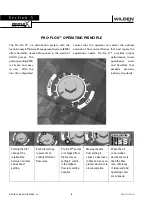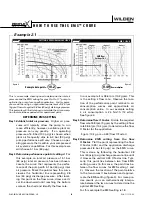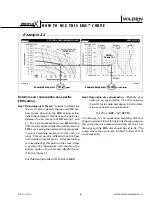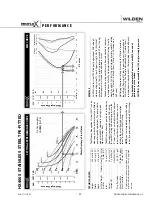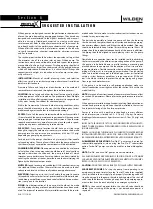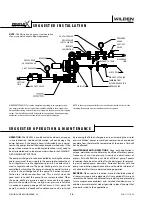
WIL-11111-E-03
15
WILDEN PUMP & ENGINEERING, LLC
T R O U B L E S H O O T I N G
PUMP WILL NOT RUN OR RUNS SLOWLY.
1. Ensure that the air inlet pressure is at least 0.4 bar (6
psig) above startup pressure and that the differential
pressure (the difference between air inlet and liquid
discharge pressures) is not less than 0.7 bar (10 psig).
2. Check air inlet filter for debris (see recom-
mended installation).
3. Check for extreme air leakage (blow by) which would indi-
cate worn seals/bores in the air valve, pilot spool, main shaft.
4. Disassemble pump and check for obstructions
in the air passageways or objects which would
obstruct the movement of internal parts.
5. Check for sticking ball check valves. If material being
pumped is not compatible with pump elastomers, swell-
ing may occur. Replace ball check valves and seals
with proper elastomers. Also, as the check valve balls
wear out, they become smaller and can become stuck
in the seats. In this case, replace balls and seats.
6. Check for broken inner piston which will cause
the air valve spool to be unable to shift.
7. Remove plug from pilot spool exhaust.
PUMP RUNS BUT LITTLE OR
NO PRODUCT FLOWS.
1. Check for pump cavitation; slow pump speed down to
allow thick material to flow into liquid chambers.
2. Verify that vacuum required to lift liquid is not greater than
the vapor pressure of the material being pumped (cavitation).
3. Check for sticking ball check valves. If material being
pumped is not compatible with pump elastomers, swell-
ing may occur. Replace ball check valves and seats
with proper elastomers. Also, as the check valve balls
wear out, they become smaller and can become stuck
in the seats. In this case, replace balls and seats.
PUMP AIR VALVE FREEZES.
1. Check for excessive moisture in compressed air; either
install a dryer or hot-air generator for compressed air.
Alternatively, a coalescing filter may be used to remove
the water from the compressed air in some applications.
AIR BUBBLES IN PUMP DISCHARGE.
1. Check for ruptured diaphragm.
2. Check tightness of outer pistons (refer to Section 7).
3. Check tightness of fasteners and integrity of O-rings
and seals, especially at intake manifold.
4. Ensure pipe connections are airtight.
PRODUCT COMES OUT AIR EXHAUST.
1. Check for diaphragm rupture.
2. Check tightness of outer pistons to shaft.
Содержание HX400S
Страница 25: ...N O T E S ...
Страница 30: ...N O T E S ...






